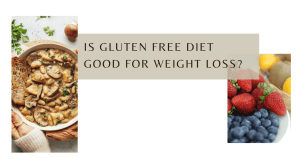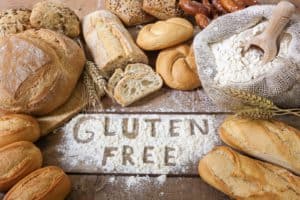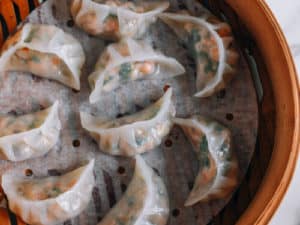A gluten-free diet is not new, as initially, it was well known for the treatment of celiac disease. One can also go for a Gluten-Free Diet For Weight Loss.
If you are willing to lose weight or improve your insulin sensitivity, you should opt for a gluten-free diet. You all might have read about A gluten-free diet for weight loss but it has other health benefits too.
Let us now understand what is gluten and why Gluten-Free Diet For Weight Loss is recommended.
What is Gluten?
Gluten is a protein that is present commonly in grains like barley, rye, and wheat.
Gluten consumption can be harmful to people with diseases such as celiac disease. A gluten-free diet is recommended for these individuals and others who suffer from gluten-related medical conditions.
Gluten-free diets claim to enhance energy, health, and weight loss efforts.
You should always do a gluten-free diet under your doctor or nutritionist’s supervision.
How does gluten-free diet works?
A gluten-free diet removes all foods containing or contaminated with gluten. Gluten is largely ubiquitous in foods, found as the main ingredient (in wheat, rye, barley, triticale, cross-contaminated oats), in sauces (soy sauce, malt vinegar, flour), and as additives or fillers (maltodextrin, wheat starch).
When initially going gluten-free, perhaps the most noticeable change is having to relinquish favorite staples of bread, pasta, cereals, and processed snack foods. Because some of these items, which are typically highly processed, may be low in nutrients and high in calories, one may feel better and even lose some weight soon after removing them from the diet.
Although there are now abundant gluten-free counterparts to take their place, a gluten-free diet usually causes one to revisit naturally gluten-free whole foods like fruits, vegetables, and grains like brown rice, quinoa, and millet. Including these minimally processed, high-fiber foods may also help to promote weight loss and a feeling of well-being.
Foods to Avoid
Completely avoiding gluten can be challenging.
This is because it is found in numerous common ingredients that are added to foods.
These are the primary sources of gluten in the diet:
- Wheat-based foods like wheat bran, wheat flour, durum, Kamut, and semolina
- Barley
- Rye
- Triticale
- Malt
- Brewer’s yeast
Some foods that may have ingredients containing gluten added to them are given below:
- Bread. All wheat-based bread.
- Pasta. All wheat-based pasta.
- Cereals. Unless labeled gluten-free.
- Baked goods. Cakes, cookies, muffins, pizza, bread crumbs, and pastries.
- Snack foods. Candy, crackers, muesli bars, pre-packaged convenience foods, roasted nuts, flavored chips, and popcorn.
- Sauces. Soy sauce, hoisin sauce, teriyaki sauce, marinades, salad dressings.
- Beverages. Beer or flavored alcoholic beverages.
- Other foods. Couscous, broth (unless labeled gluten-free).
The simplest way to avoid gluten is to eat unprocessed, single-ingredient foods. Otherwise, you should read the food labels of the products you buy,
Oats are naturally gluten-free. However, they are often combined with gluten, as they might be processed in the same factory as wheat-based foods.
Foods to Eat
Numerous gluten-free options will allow you to enjoy healthy and delicious meals.
The following foods are naturally gluten-free:
- Meats and fish. All meats and fish, except coated or battered meats.
- Eggs. All types of eggs are naturally gluten-free.
- Dairy. Plain dairy products, such as plain milk, plain yogurt, and cheese. However, flavored dairy products may have added ingredients that contain gluten, so you will need to read the food labels.
- Fruits and vegetables. All fruits and vegetables are naturally gluten-free.
- Grains. Quinoa, rice, sorghum, corn, millet, amaranth, buckwheat, tapioca, arrowroot, teff, and oats (if labeled gluten-free).
- Starches and flours. Potatoes, potato flour, chickpea flour, corn, corn flour, soy flour, almond meal/flour, coconut flour, and tapioca flour.
- Nuts and seeds. All nuts and seeds.
- Spreads and oils. All vegetable oils and butter.
- Herbs and spices. All herbs and spices.
- Beverages. Almost all beverages, omit beer (unless labeled as gluten-free).
Health Benefits of a Gluten-Free Diet
A gluten-free diet has many benefits in terms of weight loss and, for someone with celiac disease.
Here are the primary advantages of a gluten-free diet:
Can Help You Lose Weight
Consuming wheat and foods that have gluten is the staple part of our daily life. As along with gluten these foods are naturally rich in carbohydrates as well. It’s not unusual to lose when you start following a gluten-free diet. You lose weight, insulin sensitivity is improved with a better menstrual cycle which is the major consequence of PCOS.
This is because it eliminates many junk food that adds unwanted calories to the diet. These foods are often replaced by fruits, vegetables, and lean proteins.
However, it’s important to avert processed “gluten-free” foods like biscuits, cakes, pastries, and snacks, as they can quickly add a lot of calories to your diet.
May Relieve Digestive Symptoms
Many individuals try a gluten-free diet to treat digestive problems. These include bloating, constipation, diarrhea or gas, fatigue, and many other symptoms.
Studies have shown that following a gluten-free diet can help relieve digestive symptoms for people with celiac disease and non-celiac gluten sensitivity.
May Boost Energy
People with celiac disease often feel tired, sluggish, or experience “brain fog”. These symptoms may be produced by nutrient deficiencies because of damage to the gut.
If you have celiac disease, shifting to a gluten-free diet may help boost your energy levels and stop you from feeling tired and sluggish.
We can conclude that A gluten-free diet is helpful for weight loss, endurance, and improve digestion.
Get started with your Weight Loss Journey today and take a step towards a healthy lifestyle! Stay tuned for inspiring Weight Loss Journeys, and Delicious Recipes! Also, don’t forget to follow us on Instagram for the daily dose of Health, and Wellness content!









